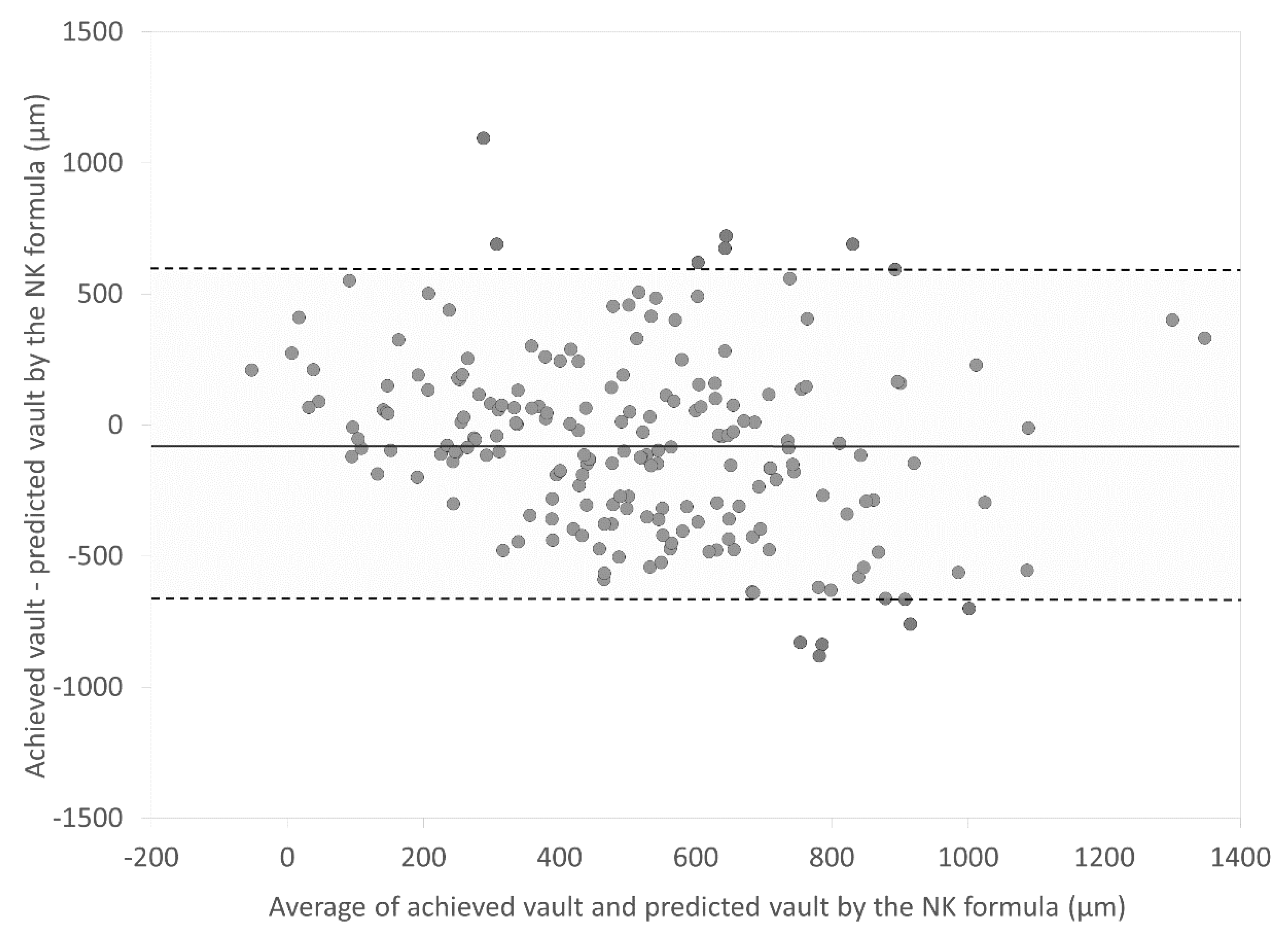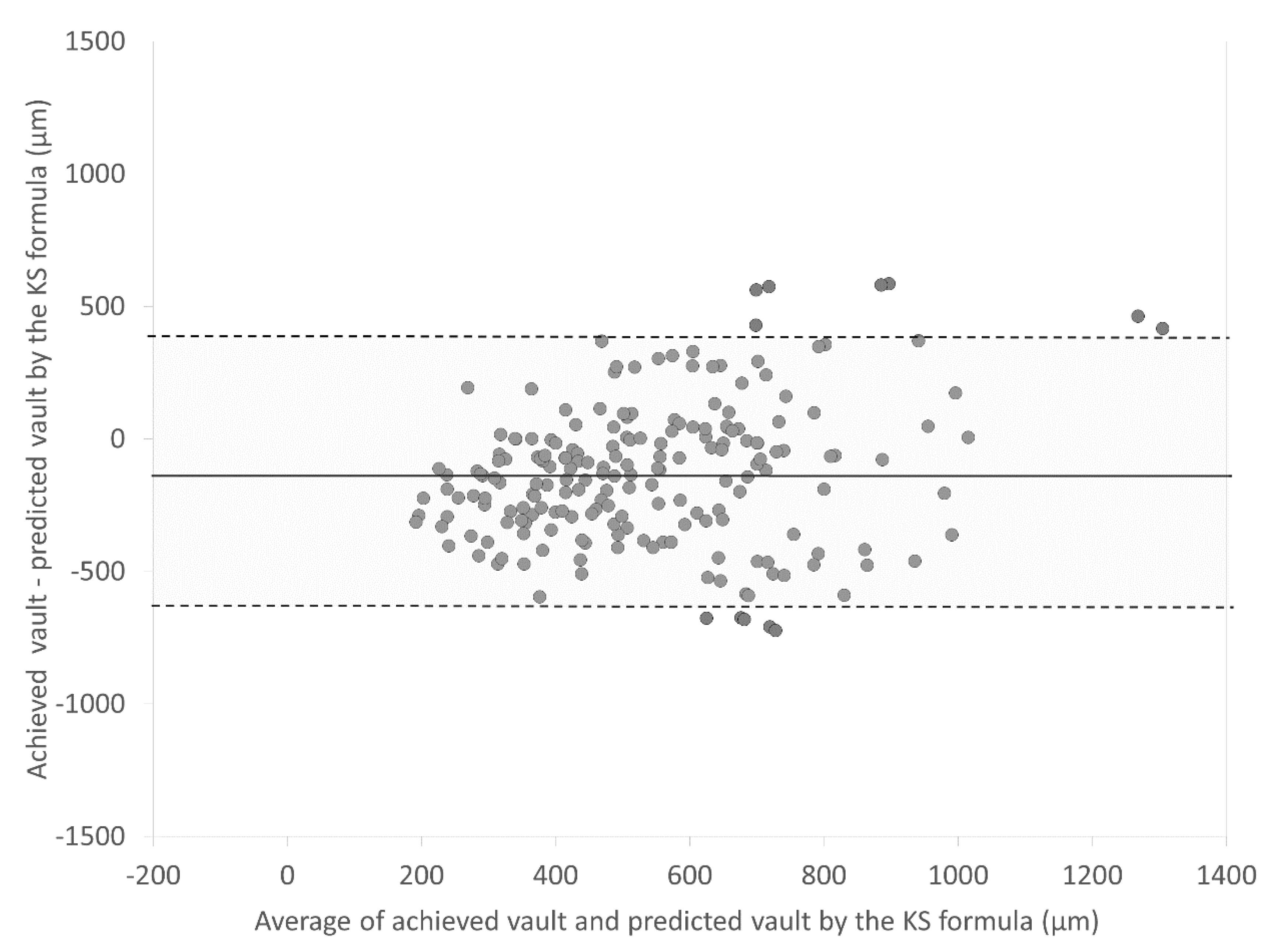Comparison of Phakic Intraocular Lens Vault Using Conventional Nomogram and Prediction Formulas
Abstract
1. Introduction
2. Patients and Methods
2.1. Study Population
2.2. Lens Size Selection and Power Calculation
2.3. Surgical Procedure
2.4. Predicted and Achieved Vault Assessment
2.5. Repeatability Assessment
2.6. Statistical Analysis
3. Results
4. Discussion
5. Conclusions
Author Contributions
Funding
Conflicts of Interest
Abbreviations
| ICL | Implantable Collamer Lens |
| WTW | white-to-white diameter |
| ACD | anterior chamber depth |
| STS | sulcus-to-sulcus diameter |
| UBM | ultrasound biomicroscopy |
| AS-OCT | anterior segment optical coherence tomography |
| ATA | angle-to-angle distance |
| D | diopter |
| SD | standard deviation |
| ACW | anterior chamber width |
| CLR | crystalline lens rise |
| ANOVA | analysis of variance |
| LoA | limits of agreement |
References
- Sanders, D.R.; Doney, K.; Poco, M.; ICL in Treatment of Myopia Study Group. United States Food and Drug Administration clinical trial of the Implantable Collamer Lens (ICL) for moderate to high myopia: Three-year follow-up. Ophthalmology 2004, 111, 1683–1692. [Google Scholar] [CrossRef] [PubMed]
- Kamiya, K.; Shimizu, K.; Igarashi, A.; Hikita, F.; Komatsu, M. Four-Year Follow-up of Posterior Chamber Phakic Intraocular Lens Implantation for Moderate to High Myopia. Arch. Ophthalmol. 2009, 127, 845–850. [Google Scholar] [CrossRef] [PubMed]
- Alfonso, J.F.; Baamonde, B.; Fernández-Vega, L.; Fernandes, P.; Méijome, J.M.G.; Montés-Micó, R. Posterior chamber collagen copolymer phakic intraocular lenses to correct myopia: Five-year follow-up. J. Cataract. Refract. Surg. 2011, 37, 873–880. [Google Scholar] [CrossRef] [PubMed]
- Igarashi, A.; Shimizu, K.; Kamiya, K. Eight-Year Follow-up of Posterior Chamber Phakic Intraocular Lens Implantation for Moderate to High Myopia. Am. J. Ophthalmol. 2014, 157, 532–539.e1. [Google Scholar] [CrossRef] [PubMed]
- Liu, S.; Yu, M.; Ye, C.; Lam, D.S.C.; Leung, C.K.-S. Anterior Chamber Angle Imaging with Swept-Source Optical Coherence Tomography: An Investigation on Variability of Angle Measurement. Investig. Ophthalmol. Vis. Sci. 2011, 52, 8598–8603. [Google Scholar] [CrossRef] [PubMed]
- Aptel, F.; Chiquet, C.; Gimbert, A.; Romanet, J.-P.; Thuret, G.; Gain, P.; Campolmi, N. Anterior Segment Biometry Using Spectral-Domain Optical Coherence Tomography. J. Refract. Surg. 2014, 30, 354–360. [Google Scholar] [CrossRef] [PubMed]
- Nakamura, T.; Isogai, N.; Kojima, T.; Yoshida, Y.; Sugiyama, Y. Implantable Collamer Lens Sizing Method Based on Swept-Source Anterior Segment Optical Coherence Tomography. Am. J. Ophthalmol. 2018, 187, 99–107. [Google Scholar] [CrossRef] [PubMed]
- Nakamura, T.; Isogai, N.; Kojima, T.; Yoshida, Y.; Sugiyama, Y. Optimization of implantable collamer lens sizing based on swept-source anterior segment optical coherence tomography. J. Cataract. Refract. Surg. 2020, 46, 742–748. [Google Scholar] [CrossRef] [PubMed]
- Igarashi, A.; Shimizu, K.; Kato, S.; Kamiya, K. Predictability of the vault after posterior chamber phakic intraocular lens implantation using anterior segment optical coherence tomography. J. Cataract. Refract. Surg. 2019, 45, 1099–1104. [Google Scholar] [CrossRef] [PubMed]
- Shimizu, K.; Kamiya, K.; Igarashi, A.; Shiratani, T. Early clinical outcomes of implantation of posterior chamber phakic intraocular lens with a central hole (Hole ICL) for moderate to high myopia. Br. J. Ophthalmol. 2012, 96, 409–412. [Google Scholar] [CrossRef] [PubMed]
- Kamiya, K.; Shimizu, K.; Igarashi, A.; Kitazawa, Y.; Kojima, T.; Nakamura, T.; Oka, Y.; Matsumoto, R. Posterior chamber phakic intraocular lens implantation: Comparative, multicentre study in 351 eyes with low-to-moderate or high myopia. Br. J. Ophthalmol. 2018, 102, 177–181. [Google Scholar] [CrossRef] [PubMed]
- Bland, J.M.; Altman, D. Statistical Methods for Assessing Agreement between Two Methods of Clinical Measurement. Lancet 1986, 327, 307–310. [Google Scholar] [CrossRef]
- Bunce, C.; Patel, K.V.; Xing, W.; Freemantle, N.; Doré, C.J.; On behalf of the Ophthalmic Statistics Group. Ophthalmic statistics note 1: Unit of analysis. Br. J. Ophthalmol. 2014, 98, 408–412. [Google Scholar] [CrossRef] [PubMed]


| Demographic | Preoperative | Postoperative (3 Months) | p-Value |
|---|---|---|---|
| Age (years) | 34.3 ± 7.8 (95%CI, 19.2 to 49.4) | ||
| Gender (male:female) | 47:53 | ||
| Manifest spherical refraction (D) | −6.98 ± 3.46 (95%CI, −13.76 to −0.21) | −0.10 ± 0.44 (95%CI, −0.96 to 0.77) | <0.001 |
| Manifest cylinder (D) | −1.08 ± 1.09 (95%CI, −3.22 to 1.66) | −0.24 ± 0.37 (95%CI, −0.97 to 0.49) | 0.004 |
| UDVA (logMAR) | 1.28 ± 0.29 (95%CI, 0.71 to 1.86) | −0.11 ± 0.19 (95%CI, −0.24 to 0.46) | <0.001 |
| CDVA (logMAR) | −0.16 ± 0.12 (95%CI, −0.40 to 0.08) | −0.22 ± 0.46 (95%CI, −0.05 to −0.38) | 0.108 |
| Intraocular pressure (mmHg) | 14.2 ± 2.6 (95%CI, 9.1 to 19.3) | 14.0 ± 2.5 (95%CI, 9.0 to 18.9) | 0.087 |
| Endothelial cell density (cells/mm2) | 2823 ± 241 (95%CI, 2350 to 3295) | 2790 ± 220 (95%CI, 2358 to 3222) | 0.158 |
| ICL Size | Eyes (%) | Achieved ICL Vault | Predicted ICL Vault Using the NK Formula | Predicted ICL Vault Using the KS Formula |
|---|---|---|---|---|
| Total | 200 (100%) | 477.1 ± 263.7 µm | 551.2 ± 335.1 µm (p = 0.014) | 606.4 ± 212.2 µm (p < 0.001) |
| 12.1 mm | 21 (10.5%) | 257.9 ± 194.3 µm | 185.6 ± 265.2 µm (p = 0.386) | 175.0 ± 83.0 µm (p = 0.157) |
| 12.6 mm | 95 (47.5%) | 460.6 ± 245.1 µm | 467.7 ± 247.5 µm (p = 0.962) | 535.0 ± 129.6 µm (p = 0.033) |
| 13.2 mm | 83 (41.5%) | 544.1 ± 262.8 µm | 732.2 ± 325.3 µm (p < 0.001) | 743.1 ± 220.6 µm (p < 0.001) |
| 13.7 mm | 1 (0.5%) | 1083 µm | 1093 µm | 909 µm |
| ICL Size | Eyes (%) | Achieved ICL Vault | Predicted ICL Vault Using the NK Formula | Predicted ICL Vault Using the KS Formula |
|---|---|---|---|---|
| V4c model (100 eyes) | ||||
| Total | 100 (100%) | 496.1 ± 334.4 µm | 662.8 ± 366.2 µm (p < 0.001) | 673.4 ± 232.9 µm (p < 0.001) |
| 12.1 mm | 13 (13.0%) | 163.4 ± 119.6 µm | 197.1 ± 248.8 µm (p = 0.817) | 380.5 ± 47.3 µm (p = 0.003) |
| 12.6 mm | 45 (45.0%) | 386.3 ± 198.7 µm | 450.6 ± 283.0 µm (p = 0.161) | 529.1 ± 142.9 µm (p = 0.004) |
| 13.2 mm | 42 (42.0%) | 539.5 ± 283.4 µm | 846.0 ± 309.2 µm (p < 0.001) | 806.4 ± 226.6 µm (p < 0.001) |
| 13.7 mm | 0 (0%) | - | - | - |
| V5 model (100 eyes) | ||||
| Total | 100 (100%) | 489.5 ± 236.3 µm | 583.9 ± 327.0 µm (p = 0.894) | 635.2 ± 212.2 µm (p = 0.211) |
| 12.1 mm | 8 (8.0%) | 411.4 ± 199.5 µm | 166.9 ± 306.9 µm (p = 0.072) | 366.0 ± 125.3 µm (p = 0.820) |
| 12.6 mm | 50 (50.0%) | 527.5 ± 264.9 µm | 483.2 ± 212.3 µm (p = 0.460) | 540.3 ± 117.5 µm (p = 0.932) |
| 13.2 mm | 41 (41.0%) | 548.7 ± 243.4 µm | 616.8 ± 302.9 µm (p = 0.223) | 678.3 ± 196.6 µm (p = 0.040) |
| 13.7 mm | 1 (1.0%) | 1083 µm | 1093 µm | 909 µm |
Publisher’s Note: MDPI stays neutral with regard to jurisdictional claims in published maps and institutional affiliations. |
© 2020 by the authors. Licensee MDPI, Basel, Switzerland. This article is an open access article distributed under the terms and conditions of the Creative Commons Attribution (CC BY) license (http://creativecommons.org/licenses/by/4.0/).
Share and Cite
Ando, W.; Kamiya, K.; Hayakawa, H.; Takahashi, M.; Shoji, N. Comparison of Phakic Intraocular Lens Vault Using Conventional Nomogram and Prediction Formulas. J. Clin. Med. 2020, 9, 4090. https://doi.org/10.3390/jcm9124090
Ando W, Kamiya K, Hayakawa H, Takahashi M, Shoji N. Comparison of Phakic Intraocular Lens Vault Using Conventional Nomogram and Prediction Formulas. Journal of Clinical Medicine. 2020; 9(12):4090. https://doi.org/10.3390/jcm9124090
Chicago/Turabian StyleAndo, Wakako, Kazutaka Kamiya, Hideki Hayakawa, Masahide Takahashi, and Nobuyuki Shoji. 2020. "Comparison of Phakic Intraocular Lens Vault Using Conventional Nomogram and Prediction Formulas" Journal of Clinical Medicine 9, no. 12: 4090. https://doi.org/10.3390/jcm9124090
APA StyleAndo, W., Kamiya, K., Hayakawa, H., Takahashi, M., & Shoji, N. (2020). Comparison of Phakic Intraocular Lens Vault Using Conventional Nomogram and Prediction Formulas. Journal of Clinical Medicine, 9(12), 4090. https://doi.org/10.3390/jcm9124090





